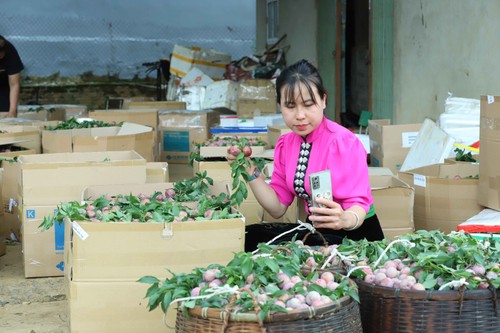In the community-based tourism village of Sin Suoi Ho, in Phong Tho District, Lai Chau Province, young Mong villagers are using livestreams to promote tourism. Their videos capture not only the stunning landscapes but also everyday village life—strolling through orchid fields, visiting stilt houses, and showcasing the making of traditional clothing.
Visitors to Sin Suoi Ho don’t just enjoy the peaceful mountain views, they get a real taste of Mong culture, and a closer look at how people here live and work, said Hang Thi Qua, a young livestreamer. She added the village now has 19 homestays that can accommodate 600 guests. Through livestreams, young people hope to send a clear message that Sin Suoi Ho isn’t just a place to visit — it’s a place to remember, and to come back to.
“Local people have started building homestays and small restaurants to serve tourists. Now, we’re adding more private rooms and bungalows so visitors can stay more comfortably. When guests feel at home, they want to stay longer, and that’s what we hope for,” said Qua.
 Young Mong ethnic minority people in Lai Chau Province are using livestreams to share their culture, show their daily lives, and invite visitors to their villages. (Photo: VOV) Young Mong ethnic minority people in Lai Chau Province are using livestreams to share their culture, show their daily lives, and invite visitors to their villages. (Photo: VOV) |
In Huoi Bao village, Phong Tho district, a group of young people are working together to promote their traditional brocade. They organize livestreams that showcase not just the products, but also the rich cultural space of the village including stilt houses, festivals, and daily life. Through platforms like Facebook, Zalo, and e-commerce sites, Huoi Bao’s brocade products are now reaching customers not only in Lai Chau, but also in cities like Ha Noi and Da Nang, and even from abroad.
“My friends and I hope to learn more technologies, so we can apply them in our daily lives and improve our family’s income. We hope local authorities would create more opportunities for us to access these technologies and knowledge,” said local weaver Vang Van Giang.
 Lai Chau boasts 200 youth-led economic models, with young people responsible for 22% of all OCOP-certified products. (Photo: VOV) Lai Chau boasts 200 youth-led economic models, with young people responsible for 22% of all OCOP-certified products. (Photo: VOV) |
Lai Chau is home to 124,000 young people, most of them are from ethnic minority groups. The province boasts 200 youth-led economic models, with young people responsible for 22% of all OCOP-certified products. From over 800 ideas proposed by local youth, more than 200 have been successfully implemented, from small-scale community businesses to innovative tech projects with long-term potential.
“Young people in Lai Chau are quickly embracing new technologies, including artificial intelligence, and actively take part in the country’s digital transformation. In today’s fast-changing world, if they don’t keep up with digital progress, they will fall behind others and miss out on many opportunities,” Nguyen Tien Thinh, Secretary of the provincial Youth Union, said.
 Farmer Tong Thi So, a Thai woman from Dau village, takes advantage of digital platforms including Facebook and TikTok to sell her fruit directly to customers. (Photo: VOV) Farmer Tong Thi So, a Thai woman from Dau village, takes advantage of digital platforms including Facebook and TikTok to sell her fruit directly to customers. (Photo: VOV) |
The plum gardens in Chieng Co Commune, Son La Province those days are busy with the sounds and sights of harvest time. Farmer Tong Thi So, a Thai woman from Dau village, is taking advantage of digital platforms including Facebook and TikTok to sell her fruit directly to customers.
Instead of relying on traders or local markets, farmers like So livestream from their gardens to showcase the quality and freshness of their fruits. This new approach allows them to reach customers far beyond their local area, opening up new opportunities.
"Before I started livestreaming, my family’s plum sales were low, and the prices were quite low too. Now I’ve been able to sell at better prices. For example, last year, after covering all expenses, I earned more than 8,000 USD,” So said.
Seeing the benefits of selling on social media and e-commerce platforms, Quang Van Doan, another Chieng Co resident learned how to make videos and livestream to promote his family’s plum products. This year, his one-hectare plum garden is expected to yield about 5 tonnes, with many customers placing orders in advance.
“Online promotion has helped us earn better prices for our high-quality plums and freed us from depending on middlemen,” said Doan.
 Livestreaming not only creates jobs for young people but also helps local households earn a better income. (Photo: VOV) Livestreaming not only creates jobs for young people but also helps local households earn a better income. (Photo: VOV) |
More than 90% of households in Chieng Co grow plums, with nearly 500 hectares and over 3,600 tonnes of fresh fruit expected this year. But using smartphones and doing livestreams isn't easy for everyone, said Tong Thi Thanh, the commune’s cultural officer.
"Livestreaming not only creates jobs for young people but also helps several families earn a better income. Most importantly, it frees farmers from having to accept low prices set by traders. We’ve organized training sessions and provided hands-on guidance tailored to local conditions, helping them use smartphones to create online storefronts and manage their orders more effectively,” said Thanh.
Ca Trung Hoa, Vice Chairman of the Chieng Co Commune People’s Committee, said, "We’re working with agencies to help people learn digital skills, connect with transport services, and build a local brand. We want to make sure our farmers benefit from their own hard work."
Digital change in these remote areas starts with a phone, a first livestream, a few orders sent out… And just like that, step by step, local people are quietly writing a new story for their villages in their own way.